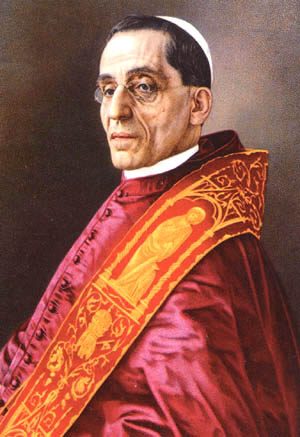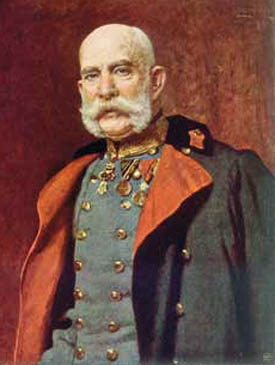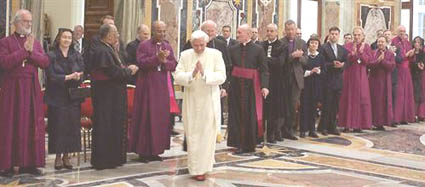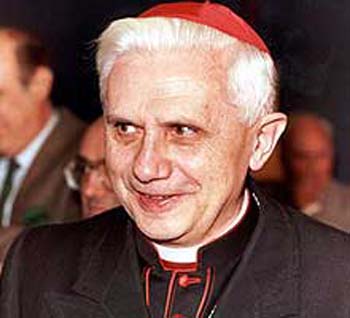 |
A Column of Catholic Orientation
The “Reconciliation” of the Two Benedicts
Marian T. Horvat, Ph.D.
The reasons for choosing papal names are curious. When Giacomo Della Chiesa was raised to the Chair of Peter as Pope Benedict XV in 1914, he affirmed that he chose that name because he was Cardinal of Bologna and wanted to pay tribute to Benedict XIV, the last Pope to be elected from the see of Bologna. Cardinal Giuseppe Sarto took the name Pius to honor the memory of Pius IX and his fight against the Revolution inside the Church. Pius XI took the same name in respect for Pius X, even though sadly he did not imitate his intransigent fight against Modernism.
John XXIII shocked the world by choosing the name that had been avoided since the last John in the early 14th century. John XXII, an Avignon Pope, preached a false doctrine about Purgatory and the Final Judgment. Only the day before he died did he retract his error. From them on, the name John was understandably avoided, but it did not frighten Angelo Roncalli. Perhaps it is because he also preached many errors, even though he did not retract any of them before he died.
The names John and Paul were successively chosen by John XXIII and Paul VI with progressivist purposes. According to the progressivist saga, there was enough of Peter in the Church – that is to say, hierarchy. From Roncalli on, what should be stressed was love – represented by John – and the evangelization of the world – represented by Paul. I don’t remember what acrobatics in symbolism the progressivists used to also link the Apostle John to the Schismatics, but that is what they did. Who can imagine comparing those dark, sinister prelates of the Schismatic “Church” to the sublime St. John? On the other hand, the sterile, bitter, and revolted Protestants are supposedly represented by St. Paul. Nothing could be more inappropriate.
As for John Paul II, needless to say, Catholics understood immediately the progressivist direction Karol Woltyla would steer the Bark of Peter by his novel decision to combine the names of the two revolutionary Vatican II Popes, John XXIII and Paul VI.

Benedict XV was not an heir of St. Pius X, but a disciple of the modernist Cardinal Rampolla |
When Cardinal Joseph Ratzinger chose the name Benedict XVI, some Catholics sighed in relief that he had honored the memory of a pre-Vatican II Pope. My friend Jan, who read several optimistic accounts presaging better days ahead for traditional Catholics, pointed this out to me. “Benedict XV was a Pope of reconciliation and peace during World War I,” she told me. She had read that he had a great devotion to Pope Pius X, and that his voice would choke when he spoke of him. “So,” she concluded, “Pope Ratzinger is telling us he will return to tradition and bring peace to the world and the Church.”
For Jan and for many others who may be fooled by similar optimistic appraisals, I think a little history review is in order.
First, the supposed grand friendship between Benedict XV and St. Pius X is quite imaginative. Under St. Pius X, Archbishop Della Chiesa (the future Benedict XV) had been sent to Bologna in exile from the Roman Curia because he was distrusted as a protégé and supporter of Cardinal Rampolla, a known modernist and freemason. Further, St. Pius X withheld the cardinal’s hat that normally went with the Bologna Archbishopric for seven years, a patent sign of his distrust and a deliberate humiliation to the arrogant Della Chiesa. Only three months before the conclave did Della Chiesa finally become a Cardinal.
In revenge, his first act after he became Pontiff was to send the valorous anti-modernist Cardinal Merry del Val packing, and to choose as Secretary of State the modernist Pietro Gasparri, another Rampolla protégé and his closest assistant. This act alone marked a clear break with the pontificate that had just ended. It certainly indicated no great devotion for St. Pius X, as we are told today, but rather fidelity to the modernist Rampolla.
Let me point out, I did not have to search hidden archives to find these facts. I simply went to my library, and checked in three different works on the Papacy and in the Catholic Encyclopedia to confirm what I knew. The election of Giacomo Della Chiesa was “as explicit a reaction against the preceding regime [of Pope St. Pius X] as it was possible to get.” (1)
1. Eamon Duffy, Saints and Sinners: A History of the Popes, (Yale University Press, 1997), p. 253.
A Rampolla protégé
To understand Benedict XV, one needs to know something about his mentor, Cardinal Mariano Rampolla, Secretary of State under Leo XIII. At the turn of the 20th century, Rampolla was already well-known for championing the errors and spirituality that St. Pius X would term Modernism. A Vatican insider, he patiently and steadily prepared the way for Vatican II and the destruction of Catholic Church that came as a consequence.

Emperor Franz Joseph used an old privilege to veto the election of the freemason Rampolla |
At the conclave after the death of Pope Leo XIII in 1903, it was expected that Cardinal Rampolla would be the next Pope, which would have been a great victory for the modernist faction. Actually, he was leading in votes when his election was suddenly vetoed. The Emperor Franz Josef of Austria-Hungary, through his representative the Cardinal of Krakow, exercised an age-old privilege and vetoed the election of Rampolla. The Emperor had been presented irrefutable evidence that the Cardinal, besides being a modernist, was a member of Freemasonry and Grand Master of the secret sect known as the Ordo Templi Orientalis. (2)
2. Mary Ball Martínez, The Undermining of the Catholic Church (Hillmac, Mexico: 1999), pp. 32-33.
During the pontificate of St. Pius X, Rampolla was forced out of the Curia. From his Nunciature in Madrid, he had to take steps backward and move his seriously injured modernist faction underground. But at the next conclave, Rampolla was ready to settle scores. This time one of his protégés would sit on the Throne of Peter. It was Giacomo Della Chiesa, a perfect candidate. He was a graduate of the Instituto Capranica, the most liberal seminary in Rome teeming with strange new theological doctrines and modernist errors. And he had a very close affiliation with Rampolla, who had chosen Della Chiesa as his private secretary.
The role of Giacomo della Chiesa: “Reconciliation”
Benedict XV came into his Papacy as Europe was entering World War I. In his first Encyclical, Ad Beatissimi issued November 1, 1914, the Pope, who refused to take sides in the Great War, made a dramatic call for peace between the warring factions of Europe. He also made it clear that inside the Church he was calling for a stop to the war against the modernists.
Even while he referred to the “admirable fruits” of previous pontificate, he called for concord among the members of the Church, that is, the modernists and the ultramontanes – the traditional Catholics who had been strengthened by Pius X. This “peace” orchestrated by Benedict XV is what gave the modernists the opportunity to emerge from their dark, semi-occult caverns back into the light of day with a comfortable position in the Church.
Next, Benedict XV targeted the most militant bloc that had organized to fight against the modernist errors, the group called the Sodalitium Pianum in France. This association of lay men supported by many priests were dedicated to keeping vigil on expressions of heresy in teaching, preaching, and publishing, following the norms set forth by Pius X. Pope Benedict XV and his Secretary of State Cardinal Gasparri dissolved the Sodalitium Pianum, calling a halt to the “anti-modernist witch hunt” in the name of reconciliation. (3)
In agreement with Rampolla and Gasparri, Benedict XV opened the doors for modernist errors to infiltrate the seminaries and Catholic schools of Europe. For example, in a new spirit of inter-confessionalism that encouraged “Christian unity,” he supported the famous Malines Conversations between Anglicans and Catholics. (4)
3. Duffy, Saints and Sinners, pp. 254-5.
4. Quoted from L'Osservatore Romano, 1958, in Martinez, The Undermining of the Catholic Church, p. 58.
Who will Cardinal Ratzinger reconcile?
In the temporal sphere, then, Benedict XV tried unsuccessfully to reconcile the warring powers of Europe. In the spiritual sphere, he was more successful in imposing a halt to the war that faithful Catholics were waging against Modernism.

In a curious Buddhist pose Ratzinger greets the representatives
of the false religions
Osservatore Romano, Arturo Mari |
Now, since the first days of his pontificate, Benedict XVI has been speaking of peace, reconciliation, and concord. Speaking in Clementine Hall of the Apostolic Palace to representatives of the schismatic, heretical and pagan sects, he appealed to believers of all “religions” to become promoters of peace and unity. (5)
5. “Church Committed to Ecumenism, Says Pope,” Zenit, April 25, 2005.
In the first few weeks of his Papacy, he already stated his aim to dialogue and build more bridges with Muslims, Jews, and even Buddhists. He also announced he was ready to take steps to achieve “communion” with the Schismatics and Anglicans. We already know that as Cardinal, he masterminded the “breakthrough” agreement that resulted in the signing of the disastrous Catholic-Protestant accord on the doctrine of justification in Augsburg in 1999 [click here to know its serious consequences].

If the Pope imposes the acceptance of Vatican II and its consequences on traditionalist Catholics, he should be resisted
Esmas.com, May 16, 2005 |
To date, therefore, everything leads one to believe that Benedict XVI will follow the ecumenical path forged by the post-conciliar Popes. But I think that most probably Ratzinger has another item on his agenda.
I believe Benedict XVI intends to oblige traditionalist Catholics to “reconcile” with Vatican II and the New Mass, to finish with our resistance and incorporate us in the Conciliar Church. It would be a maneuver similar to that of Benedict XV 100 years ago, when he struck his blow at the Sodalitium Pianum and the anti-modernist reaction. It is my opinion that we should be prepared for this kind of progressivist maneuver.
Who knows what overtures of “reconciliation” Benedict XVI will make to the traditionalist Catholics to silence their growing opposition to the Council? He would, I believe, permit a broader practice of the indult Tridentine Mass, perhaps even grant a broader apostolic prelature to say the Tridentine Mass than what was allowed in Campos. This would be granted only if traditional Catholics would compromise and accept Vatican II and all its consequences.
What should be the position of Catholics at this important juncture?
• To be aware of the maneuver that is probably being prepared.
• To continue our resistance against the errors of Vatican II and its consequences.
• To offer an intransigence opposition to any proposition that implies acceptance of error.
• To display an invariable determination to remain always within the bosom of the Holy Roman Catholic and Apostolic Church and remain faithful to her perennial teachings.
• To maintain a firm belief in the promise of Our Lady that she will intervene and restore Holy Mother Church to shine again with her purest doctrine and lead the world to build the Reign of the Immaculate Heart of Mary.

Posted on March 25, 2005

Related Topics of Interest
 The True Colors of Benedict XVI The True Colors of Benedict XVI
 The October Revolution The October Revolution
 Non Possumus Non Possumus
 Ratzinger on Feminism Ratzinger on Feminism
 A Conversion? Questions about Ratzinger's Dominus Jesus? A Conversion? Questions about Ratzinger's Dominus Jesus?
 The Progressivist Orientation of Pope Ratzinger The Progressivist Orientation of Pope Ratzinger
 Ratzinger Flip Flops on Communion for Pro-abortion Politicians Ratzinger Flip Flops on Communion for Pro-abortion Politicians
 Protestant Theologian Oscar Cullmann Considered Ratzinger a Radical Protestant Theologian Oscar Cullmann Considered Ratzinger a Radical

|
Related Works of Interest
|
Talks with Jan | Religious | Home | Books | CDs | Search | Contact Us | Donate

© 2002-
Tradition in Action, Inc. All Rights Reserved
|
 |
|